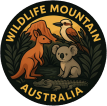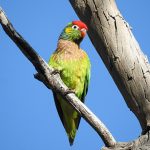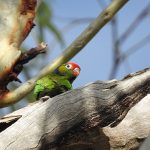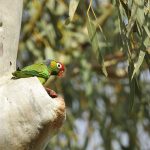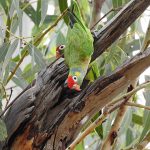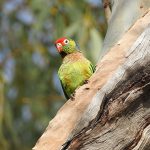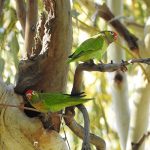VARIED LORIKEET
The Varied Lorikeet: A Jewel of Northern Australia
Among the vibrant tapestry of Australia’s northern forests and savannahs, the Varied Lorikeet flits like a living gemstone. This small parrot, with its kaleidoscopic feathers and lively personality, is both an ecological marvel and a symbol of the delicate balance within Australia’s wild places.
Habitat and Range
| Region | Habitat Types |
|---|---|
| Northern & Eastern QLD | Rainforest, monsoon forest, woodland, open savannah |
| Cape York Peninsula | Coastal & adjacent island environments |
- Geographical Range: Predominantly found across northern and eastern Queensland, including the lush Cape York Peninsula and nearby islands.
- Preferred Environments: Thrives in both coastal and inland areas, especially where water is near and flowering native plants abound.
Vivid Description
Imagine standing at the edge of a sunlit rainforest. The air is warm and thick with the scent of eucalyptus and blossoming melaleuca. Suddenly, a flash of emerald streaks past—an adult Varied Lorikeet.
Adult Appearance
- Plumage: Predominantly green, like the canopy above.
- Head: A yellowish-green crown, gleaming in dappled sunlight.
- Chest: A bold red patch, contrasting vibrantly.
- Wings: Blue markings shimmer amid the green feathers.
- Forehead: A distinct blue band, like a painter’s brushstroke.
- Beak: Bright red, perfectly suited for sipping nectar.
Juvenile birds, in contrast, wear softer, less defined colours, blending gently with their surroundings as they grow and gain confidence.
Feeding and Behaviour
Diet
- Nectar and Pollen: Their preferred food, sourced from blossoms of native trees. Their brush-tipped tongues are a marvel of adaptation, designed to sweep up sweet nectar and fine pollen.
- Fruits and Berries: Soft, ripe fruits add variety to their diet.
- Insects: Occasionally, they supplement their meals with small insects.
Social Life
- Flocks: Highly social, Varied Lorikeets are rarely seen alone. Their calls—a flurry of high-pitched, cheerful notes—echo through the canopy as they travel in groups.
- Mixed-Species Flocks: Sometimes, they join other lorikeet species, creating a vivid, moving tapestry of colour and sound above the treetops.
- Flight: Agile and acrobatic, they dart and swoop with astonishing precision, their wings beating a rapid, whispering rhythm through the air.
Breeding and Life Cycle
- Season: August to January, when food is plentiful.
- Nesting: Secure tree hollows serve as safe nurseries.
- Eggs: Typically 2–3, incubated by both parents.
- Chick Rearing: Both mother and father diligently feed and protect the chicks, who fledge after several weeks, their first flights tentative but full of promise.
Conservation Notes
While still relatively common within their range, Varied Lorikeets face ongoing threats:
- Habitat Loss: Clearing of forests and woodlands for agriculture or development reduces nesting and feeding sites.
- Introduced Predators: Species such as cats and rats can threaten eggs and chicks.
- Climate Change: Alterations in rainfall and flowering times can impact food availability.
Why Conservation Matters
Protecting the habitats of the Varied Lorikeet is about more than saving a single species—it’s about preserving the rich web of life that sustains Australia’s unique ecosystems. Each lorikeet, with its dazzling colours and lively calls, is an ambassador for the wild places we all share responsibility for.
Emotional Connection
Picture a flock of Varied Lorikeets at sunrise, their feathers glowing in golden light, voices rising in joyful chorus. Their presence is a reminder of nature’s brilliance and the need to cherish the wild wonders around us.
The Varied Lorikeet is not just a bird—it is a living celebration of Australia’s natural diversity. By learning about and caring for these remarkable creatures, we help ensure that future generations, too, will marvel at their beauty and vitality.
Let every sighting of a Varied Lorikeet inspire us to protect the landscapes they call home—so their colours and songs remain a cherished part of Australia’s story.
Photo Gallery
Sharon: One place we love going to Camp is out past Cloncurry, North Queensland, Australia, where there is a beautiful shady area alongside a picture perfect Billabong. The Trees are full of hollows that are perfect nesting sites for the Varied Lorikeet as well as many other parrots, including Budgies. At nesting time there are lots of birds everywhere busying themselves with mating, nest making and rearing young. Perfect to take some ‘Close Encounter’ videos while just sitting at our campsite.
